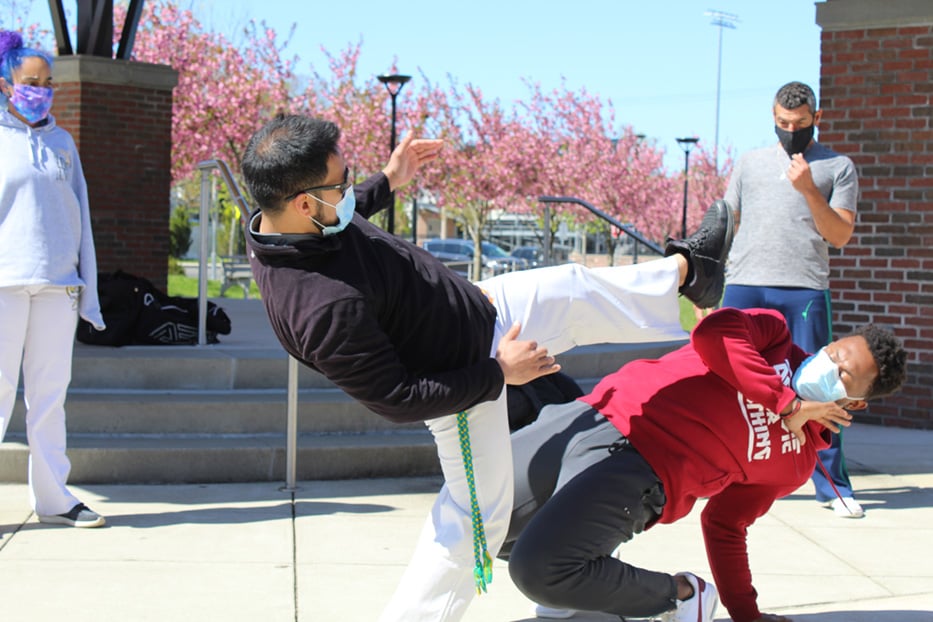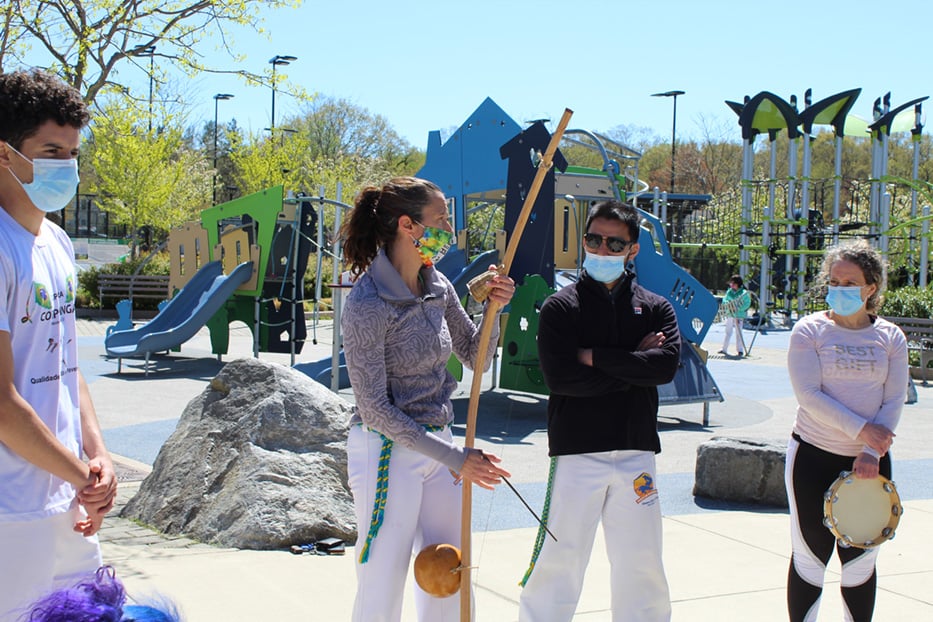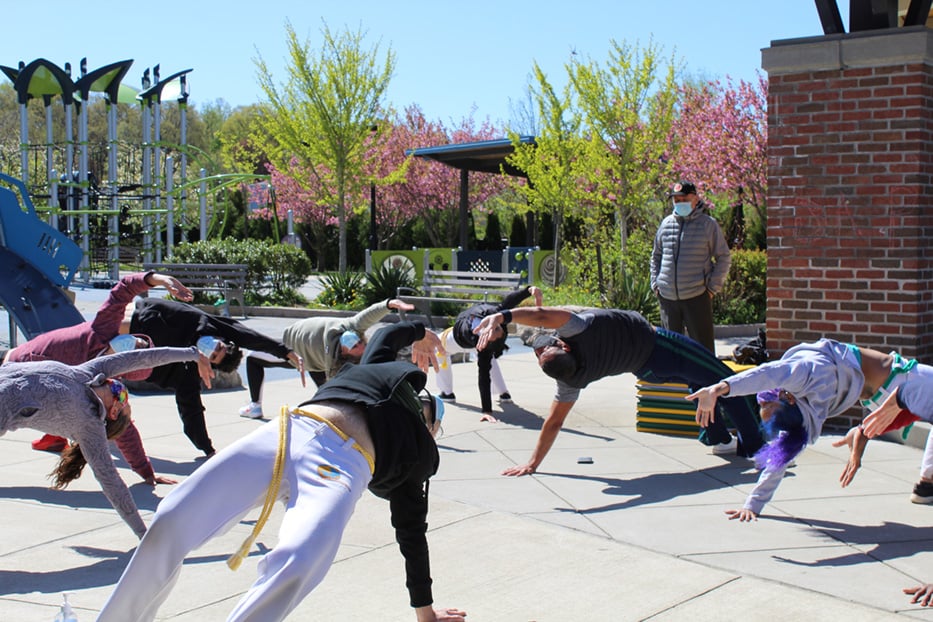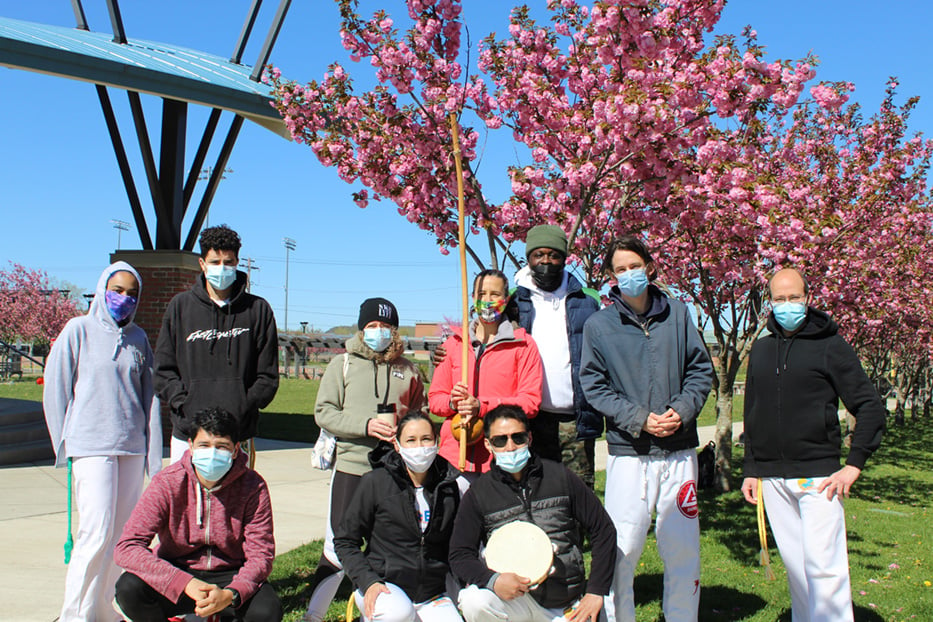 Daniel Carbajal practicing with Leo Burke. Arturo Pineda Photos.
Daniel Carbajal practicing with Leo Burke. Arturo Pineda Photos.
Daniel Carbajal and Josephine Bazzano faced one another, rocking back and forth on their feet to the beat of the berimbau and pandeiro (tambourine). When the moment came, Bazzano cartwheeled (aú fechado) over Carbajal’s head, and as she landed he cartwheeled over her with his feet inches away from her torso. They landed and fell back in line with the beat.
The duo took part in Capoeira Esperança’s Saturday morning classes at Villano Park, tucked away on Mill Rock Road Hamden. As part of an ongoing series, teachers Carbajal and Lisa Bergmann—also known as Prof Robozinho and Prof Fominha respectively— host one-hour capoeira classes in the park each weekend.
After a year of practicing via Zoom, the group returned to in person events two weeks ago. Capoeira Esperança offers a youth class at 9 a.m., followed by an adult class at 10 a.m. They hope to expand their offerings and branch out to more parks, said Bergmann.
 Lisa Bergmann (center left) and Daniel Carbajal (center right) teach the group about the berimbau held by Bergmann.
Lisa Bergmann (center left) and Daniel Carbajal (center right) teach the group about the berimbau held by Bergmann.
Capoeira, a dance infused martial art, was developed by African slaves in Brazil at the beginning of the 16th century. At the time, it was illegal and punishable for slaves to practice fighting techniques, and the music and dance elements helped disguise the martial artistry of the form. The medium became illegal after Brazil abolished slavery in 1888, and did not become accepted until the 1930s, when capoeira schools began opening.
Even though the art was developed in response to enslavement, it has always been about avoiding fight and defending others, Carbajal said.
“They are trained how to fight so they don’t have to fight,” he said. “It is very easy to harm people and hard to heal. It is about defending other people.”
He came across the art 14 years ago after he made a food delivery to his future master, Mestre Efraim Silva. Since then he’s been hooked. He is now in his ninth year of teaching. Similarly, Bergman started learning from Silva 18 years ago. When Silva’s Brazilian Fitness Center became a casualty of the Covid-19 pandemic last year, Bergman and Carbajal picked up where their master left off. Silva now lives in Florida.

The group practices stretching before sparring with one another.
After stretching, the group warmed up with a quick two laps around the park before breaking out into pairs. They practiced the ginga—the rocking back and forth footwork—before dropping to the group to practice their cartwheels.
Some of the participants have been students of capoeira for years, and travel to where it is available. Abby Rivera-Quinones, a student of 10 years, came from Meriden and brought her daughter, Isabel, with her. As a second-generation martial artist, Rivera-Quinones grew up doing karate , so the transition to capoeira was natural. She hopes that her daughter will continue the tradition if she chooses to.
Leo Burke, who also goes by “Parrudo,” drove from Farmington after hearing the classes would resume in person. He has taken classes for six years. He praised the art form’s appreciation for the body and reverence for a history of resilience.
“It is celebrating the movement your body can do,” he said. “We are paying homage to the people who did it back in the day to stand up against their masters.”
 Members of the class photographed together.
Members of the class photographed together.
New Havener Bazzano tried other exercises but never felt satisfied with them. She felt a sense of boredom and dread with them, she said. After discovering capoeira, she stuck with it for over 10 years. She now practices with different groups across the state.
“I smile when I do this [capoeira],” she said. “I can do this at my own pace and it’s not only physical.”
Richard Joyner, a lifelong Newhallville resident, has had an off-and-on relationship with capoeira since the 1980s. In the wake of the May Day Trials in 1970, karate classes for self-defense sprung up in the neighborhood. He was a trained West African Dancer and wanted something with more movement. He described falling in love with capoeira at first sight and never looking back.
To close out the class, the group formed a circle with two people at the center sparring with one another. As they clapped and strummed the instruments, members slipped in and out ensuring everyone spared with everyone else. With each duo, the rhythm of the music changed to match the intensity as a testament to the fluidity and welcoming nature of the art.
